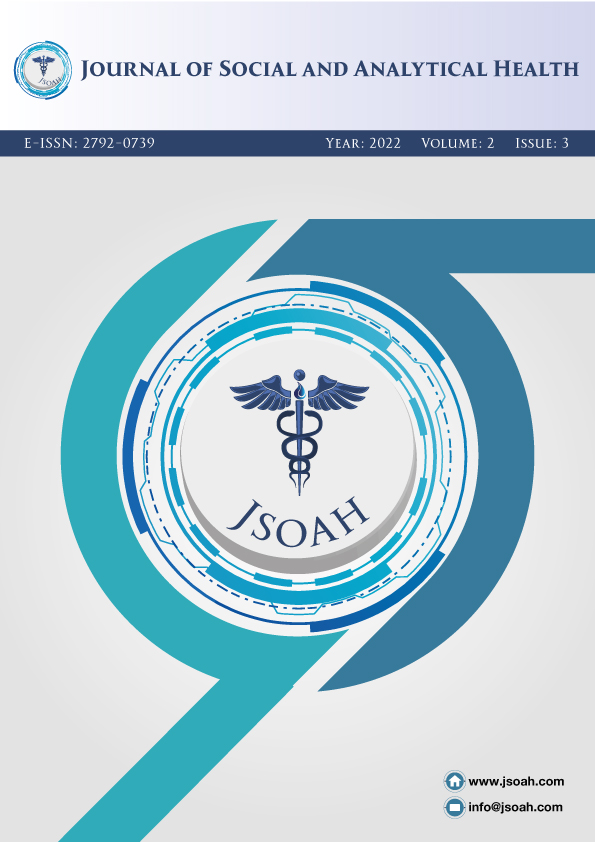Covid-19 pozitif hastalarının kan değerleri ile mortalite arasındaki ilişkinin incelenmesi: Retrospektif bir analiz
DOI:
https://doi.org/10.5281/zenodo.7251456Anahtar Kelimeler:
Acil Servis, Covid 19, Mortalite, Kan Değerleri, Retrospektif AnalizÖzet
Amaç: COVID-19 nedenli mortalite oranlarını birçok faktör etkilemektedir. COVID-19, hasta kan parametrelerinde birçok değişikliğe yol açmaktadır. Bu nedenle çalışmamızda, Acil servise başvuran COVID-19 hastalarının temel laboratuvar bulgularının analizi ile COVID-19 nedenli mortalite arasında bir ilişki olup olmadığını değerlendirmeyi amaçladık.
Gereç-Yöntem: COVID-19 tanısı ile Acil servise başvuran hastalardan alınan kan ölçüm değerleri, geriye dönük olarak değerlendirildi. Elektronik ortamda hastaların safahatı incelerek, iyileşme ve ölüm olarak kaydedildi. Çalışmaya, toplam 3965 hasta çalışmaya dahil edilmiş olup, radyolojik pozitif ama PCR testi negatif olan hastalar çalışmaya dahil edilmemiştir.
Bulgular: Hastaların sağlıklı veya vefat etmiş olmasının lökosit, lenfosit, HGB, MPV, Bazofil, Nötrofil, CRP, PTZ, INR ve paCO₂ düzeyinde istatistiksel olarak anlamlı bir farklılık tespit edilmişken (p<0,05); Platelet, Eozinofil, ALT, AST, CK ve O₂ düzeyinde istatistiksel olarak anlamlı bir farklılık oluşturmadığı tespit edilmiştir (p>0,05). Bu bulgulara göre Ortalama Trombosit Hacminin, Lökosit, Bazofil, Nötrofil, CRP ve PaCO2 değerlerinin yüksek olması; Lenfosit, Hemoglobin, PTZ ve INR değerlerinin düşük olması mortalite ile anlamı ilişki olarak değerlendirilmiştir.
Sonuç: Lökosit, nötrofil ve lenfosit, CRP, pıhtılaşma süreleri ve aneminin, COVID nedenli mortalite oranlarını tahmin etmek için önemli parametreler olduğunu düşünmekteyiz. Bu parametrelere sahip COVID hastalarının yakın takibinin faydalı olacağı bilinmelidir.
Referanslar
World Health Organization. WHO declares COVID-19 a pandemic. 2020 [cited 2020 March 13]. Available from: https://www.who.int/dg/speeches/ detail/whodirector-general-s-opening-remarks-at-the-media-briefing-onCOVID-19---11- march-2020
Johns Hopkins University and Medicine. Coronavirus Resource Center. COVID-19 Dashboard by the Center for Systems Science and Engineering (CSSE) at Johns Hopkins University (JHU). https://coronavirus.jhu.edu/map.html [cited 2020 May 7].
Cao X. COVID-19: immunopathology and its implications for therapy. Nat Rev Immunol. 2020; 20(5):269-270
Henry BM, de Oliveira MHS, Benoit S, Plebani M, Lippi G. Hematologic, biochemical and immune biomarker abnormalities associated with severe illness and mortality in coronavirus disease 2019 (COVID-19): A meta-analysis [published online ahead of print, 2020 Apr 10]. Clin Chem Lab Med. 2020;/j/cclm.ahead-of-print/cclm-2020-0369/cclm-2020-0369.xml. doi:10.1515/cclm2020-0369
Kermali M, Khalsa RK, Pillai K, Ismail Z, Harky A. The role of biomarkers in diagnosis of COVID-19- A systematic review [published online ahead of print, 2020 May 13]. Life Sci. 2020. doi: 10.1016/j.lfs.2020.117788
Wang Y, Ju M, Chen C, Yang D, Hou D, Tang X, et al. Neutrophil-to-lymphocyte ratio as a prognostic marker in acute respiratory distress syndrome patients: a retrospective study. J Thor Dis. 2018; 10(1):273-282
Sun S, Cai X, Wang H, He G, Lin Y, Lu B, et al. Abnormalities of peripheral blood system in patients with COVID-19 in Wenzhou. China. Clin Chimica Acta. 2020; 507:174-180.
Hu L, Chen S, Fu Y. Risk factors associated with clinical outcomes in 323 COVID-19 hospitalized patients in Wuhan, China. Clin Inf Dis. 2020; 71(16):2089–2098.
Lee N, Hui D, Wu A, Chan P, Cameron P, Joynt GM, et al. A major outbreak of severe acute respiratory syndrome in Hong Kong. N Engl J Med. 2003; 348:1986-1994. https://doi.org/10.1056/NEJMoa030685
Violi F, Cangemi R, Romiti GF, Ceccarelli G, Oliva A, Alessandri F, et al. Is albumin predictor of mortality in COVID-19? Antioxid Redox Signal. 2021 Jul 10;35(2):139-142. doi: 10.1089/ars.2020.8142. Epub 2020 Jun 22. PMID: 32524832
Tufan A, Avanoğlu Güler A, Matucci-Cerinic M. Covid-19, immune system response, hyperinflammation and repurposing antirheumatic drugs. Turk J Med Sci. 2020;50(SI-1):620-32.
Lagunas-Rangel FA. Neutrophil-to-lymphocyte ratio and lymphocyte-to-C-reactive protein ratio in patients with severe coronavirus disease 2019 (Covid-19): A meta-analysis [published online ahead of print, 2020 Apr 3]. J Med Virol. 2020;10.1002/jmv.25819. doi:10.1002/jmv.25819.
Güçlü E, Kocayiğit H, Okan HD, Erkorkmaz U. Effect of COVID-19 on platelet count and its indices. Rev Assoc Med Bras. 2020; 66(8):1122-1127
Zhao Q, Meng M, Kumar R, Wu Y, Huang J, Deng Y, et al. Lymphopenia is associated with severe coronavirus disease 2019 (Covid-19) infections: a systemic review and meta-analysis. Int J Infect Dis. 2020;96:131-135.
Lippi G, Plebani M, Henry BM. Thrombocytopenia is associated with severe coronavirus disease 2019 (Covid-19) infections: a meta-analysis. Clin Chim Acta. 2020;506:145-148.
Yang X, Yang Q, Wang Y, Wu Y, Xu J, Yu Y, et al. Thrombocytopenia and its association with mortality in patients with Covid-19. J Thromb Haemost. 2020;18(6):1469-1472.
Nalbant A, Kaya T, Varim C, Yaylacı S, Tamer A, Cinemre H. Can the neutrophil/lymphocyte ratio (NLR) have a role in the diagnosis of coronavirus 2019 disease (Covid-19)?. Rev Assoc Med Bras. 2020; 66(6):746-751.
Huang I, Pranata R. Lymphopenia in severe coronavirus disease-2019 (Covid-19): systematic review and meta-analysis. J Intensive Care. 2020;8:36.
Sun J, Aghemo A, Forner A, Valenti L. Covid-19 and liver disease. Liver Int. 2020;40:1278-1281.
Feng G, Zheng KI, Yan QQ, Rios RS, Targher G, Byrne CD, et al. COVID-19 and liver dysfunction: current insights and emergent therapeutic strategies. J Clin Transl Hepatol. 2020;8(1):18-24.
Wong SH, Lui RN, Sung JJ. Covid-19 and the digestive system. J Gastroenterol Hepatol. 2020;35(5):744-748.
Zheying T,Jing X,Wei C,Zhitao Y. Anemia is associated with severe illness in Covid-19: A retrospective cohort study. J Med Virol. 2021; 93 (3): 1478-1488.
Silveira EC. Prediction of Covid-19 from hemogram results and age using machine learning - .Hamara Journals. 2020; (9):1-10.
Xinye L, Xiandu P, Yanda L, Na A. Cardiac injury associated with severe disease or ICU admission and death in hospitalized patients with Covid-19: a meta-analysis and systematic review. Crit Care. 2020;24(1):468.
Lin J, Yan H, Chen H, He C, Lin C, He H, et al. COVID-19 and coagulation dysfunction in adults: A systematic review and meta-analysis. J Med Virol. 2021 Feb;93(2):934-944.
H Long, L Nie, X Xiang, H Li, X Zhang, X Fu, D-dimer and prothrombin time are the significant indicators of severe COVID-19 and poor prognosis. Hindawi. BioMed Research International. 2020; 6159720 https: //doi.org/ 10.1155/2020/6159720.
Keçeli S. Sağlık bakım hizmetleri alanında yapılan inovasyon konulu makalelerin bilim haritalama teknikleriyle analizi. Elektronik Sosyal Bilimler Dergisi, 2022;21(83): 1201-1224.
Kurutkan MN, Orhan F, Kaygısız P. Hasta güvenliği literatürünün bibliyometrik analizi: Türkçe tez ve makaleler örneği. Sağlık Akademisyenleri Dergisi. 2017; 4(4): 253-259.
İndir
Yayınlanmış
Nasıl Atıf Yapılır
Sayı
Bölüm
Lisans
Telif Hakkı (c) 2022 Journal of Social and Analytical Health

Bu çalışma Creative Commons Attribution-NonCommercial 4.0 International License ile lisanslanmıştır.


